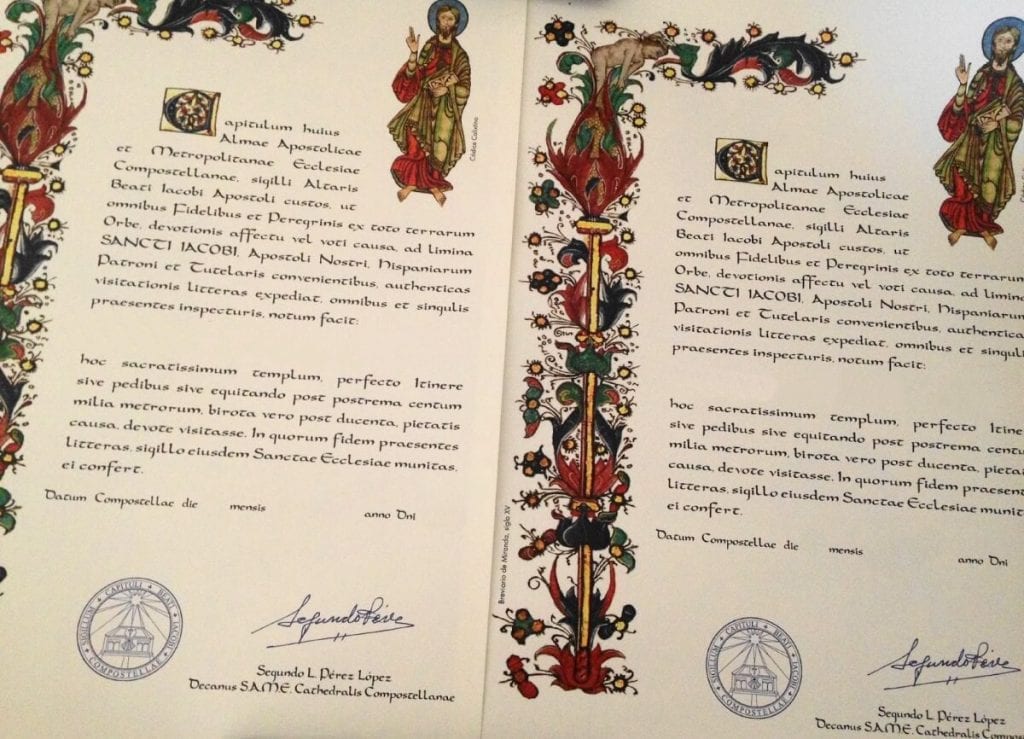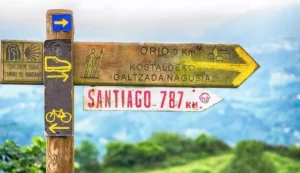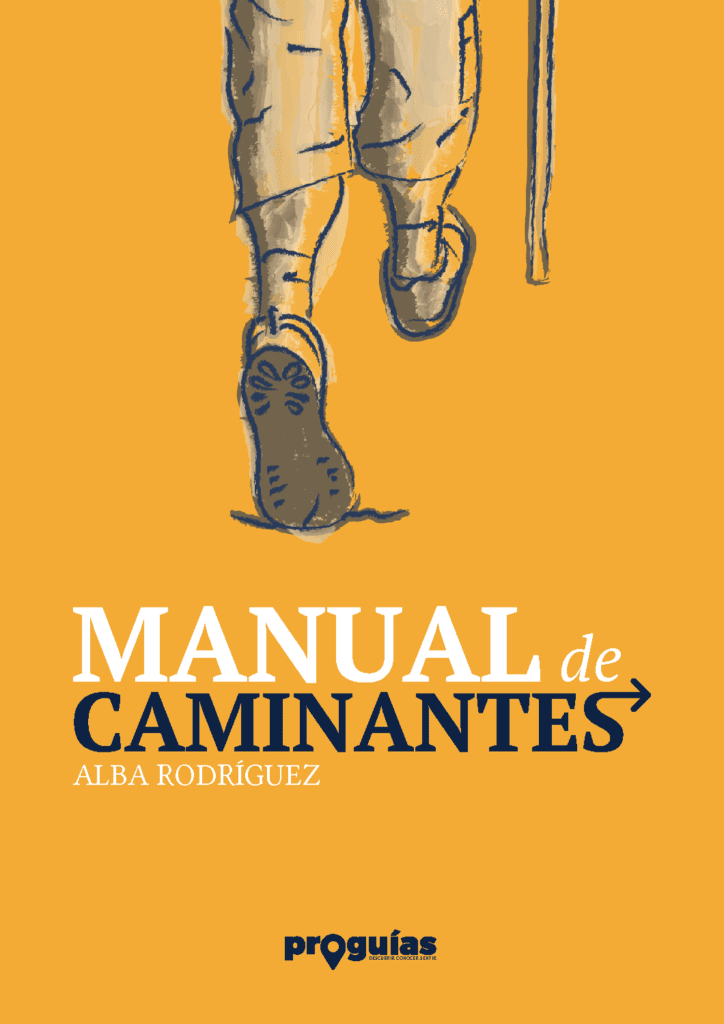If you are thinking of doing the Camino de Santiago you would have already heard of the Compostela, the Pilgrim's Credential, the stamps, etc.. This is a series of documents of the Camino de Santiago that should be known. That is, it is about knowing not only its existence, but also its meaning and its requirements. So you will know what to expect when you reach your goal.
The Jacobean pilgrimage can be considered a finalist phenomenon. That is to say, it has a goal. Historically, that goal was to reach Santiago de Compostela to venerate the remains of the apostle St. James the Elder and, in payment for that sacrifice, to receive plenary indulgences. The Compostela was the document obtained after arrival in the city. The material trophy of a pilgrimage that, until the modern recovery of the Camino, was mainly religious. Today the motifs have diversified, and consequently new documents have appeared, which we discuss below.
The Compostela: a religious document
The Compostella (or, more modernly, the Compostela) is a diploma that the Chapter of the Cathedral of Santiago issues in recognition of the effort of the pilgrimage. It is a religious document, and is only given to those pilgrims who have made the Camino for religious or spiritual reasons. This means that if you have made your pilgrimage for cultural, sporting, adventure or recreational reasons, the Pilgrim's Office will not give you this document.

In addition to the religious or spiritual motive, the attainment of the Compostela other requirements must be met. It is necessary to have covered at least the last 100 kilometres on foot or on horseback, or 200 kilometres if cycling. The only ways to be considered are the ways considered "official"including its signposted variants, and the pilgrim's credential must also be filled in correctly.
§ Learn more: The question of kilometres on the English Way from A Coruña.
In any case, the requirement to do at least the last 100 or 200 km does not prevent you from doing more, nor does it prevent you from spreading it over different periods. In other words: if you want to do the Camino from Saint Jean Pied-de-Port, for example, but you do not have a long month to cover the 755km that separate this Pyrenean town from Compostela, you can divide the pilgrimage into several periods. The only requirement is that the stamps on the Pilgrim's Credential appear in chronological and geographical order. This subject is dealt with in more detail in our article on the credential.
This is the text that appears on the diploma:
Capitulum huius Almæ Apostolicæ et Metropolitanæ Ecclesiæ Compostellanæ, sigilli Altaris Beati Iacobi Apostoli custos, ut omnibus Fidelibus et Peregrinis ex toto terrarum Orbe, devotionis affectu vel voti causa, ad limina Sancti Iacobi, Apostoli Nostri, Hispaniarum Patroni et Tutelaris convenientibus, authenticas visitationis litteras expediat, omnibus et singulis præsentes inspecturis, notum facit:
…
hoc sacratissimus templum, perfecto Itinere sive pedibus sive equitando post post postrema centum milia metrorum, birota vero post ducenta, pietatis causa, devote visitasse.
In quorum fidem præsentes litteras, sigillo eiusdem Sanctæ Ecclesiæ munitas, ei confert.
Datum Compostellæ die (...) mensis (...) anno Dni (...).
The Chapter of this Holy Apostolic and Metropolitan Cathedral Church of Compostela, custodian of the seal of the Altar of St. James the Apostle, to all the Faithful and pilgrims who come from any part of the Earth with an attitude of devotion or because of a vow or promise to make a pilgrimage to the Tomb of the Apostle, Our Patron and Protector of Spain, certifies to all those who observe this document that:
…
has devoutly and Christianly visited this most sacrosanct temple after having travelled the last one hundred kilometres on foot or on horseback or cycled the last two hundred kilometres in a Christian way.
In witness whereof I give you the present document countersigned with the seal of this same Holy Church.
Given at Compostela, on the (...) day of (...) in the year of (...).
If you have thought about doing the Camino with children, keep in mind that the Archbishopric of Santiago only grants the Compostela to boys and girls over 9 years of age. It is necessary that they have made their first communion or that "they have already started the religious preparation for the First Communion". This age limitation is due to the fact that the Cabildo does not consider children under that age to be mature enough to prove that they have made the Camino for religious reasons. In its own wordswill receive the Compostela those who have "the capacity to understand what is meant by the spiritual or religious nature of the Camino".
Handbook of Pilgrims
Download the most complete guide to prepare the Camino de Santiago from scratch and step by step.
An alternative to the Compostela: the welcome document
People who do the Camino de Santiago for reasons other than religious or spiritual ones cannot receive the Compostela. However, there are other accreditation documents that they can obtain.
Firstly, the so-called Welcome Certificate, which is similar to the Compostela, but lacks its religious value. This is the document that people who mark cultural reasons on the application form receive. The distance requirements, however, are the same as those for the Compostela. That is, you will also have to cover at least the last 100km on foot or horseback, or 200km by bike.
The document was updated in 2014, with a Latin text headed by a reference to the Codex Calixtinus, followed by the following text. We show it here translated - in the spirit of public service.
Capitulum huius Almæ Apostolicæ et Metropolitanæ Ecclesiæ Compostellanæ, omnibus hanc visitationis chartam legentibus notum facit:
…
hanc Basilicam et Sancti Iacobi Sepulcrum visitasse.
Ei advenienti Capitulum Metropolitanum summo gaudio salutem in Domine dicit, et officio caritatis ductum precatur ut Pater per ipsius Apostoli intercessionem ei trubuere dignetur non tantum bona humani corporis, sed etiam inmateriales peregrinationes opes.
A benedicto Iacobo benedicatur.
Datum Compostellæ die (...) mensis (...) anno Dni (...).
The Chapter of this Apostolic and Metropolitan Church of Compostela, makes it known to each and every one of those who see this letter of visitation that:
…
visited this Basilica and the Sepulchre of Santiago.
On this occasion, the Metropolitan Chapter, with great joy, gave him the greeting of the Lord and, moved by the duty of charity, asked, through the intercession of the Apostle, that the Father would deign to grant him not only a good life, but also the immaterial benefits of the pilgrimage.
St. James bless and be blessed.
Given at Compostela, on the (...) day of (...) in the year of (...).
The heading with the quotation from the Codex Calixtinus reads as follows
"Omnes dies et noctes quasi sub una sollempnitate continuato gaudio ad domini et apostoli decus ibi excoluntur. Valve eiusdem basilice minime clauduntur die noctuque, et nullatenus nox in ea fas est haberi atra, quia candelarum et cereorum splendida luce ut meridies fulget".
"Splendour pervades every day and night, as under a continual joyful solemnity to the Lord and the Apostle. The doors of the cathedral itself are rarely closed day or night, and it is ordained that night has no place in it, because the splendid light of candles and candles shines like noon".
The distance certificate
In recent years, due to requests from many pilgrims who did more than the last hundred or two hundred kilometres required, the Cabildo offers another document. It is called the Distance Certificate, and to a large extent it has come to replace the welcome document.
This new certificate, written in Spanish and not in Latin, indicates the name of the person who made the pilgrimage, the place and date of the start of the pilgrimage, the date of arrival in Santiago and the number of kilometres completed. Please note that the requirements are the same: 100km on foot or on horseback and 200km by bicycle.
In addition, the distance certificate must be requested in advance, directly from the Pilgrim's Office (you can do so by writing to the cathedral e-mail address)
By the way, if you have done the Camino before, you can also request this certificate. You only have to contact the Pilgrim's Office by the same means and following their instructions.
The visit certificate
Finally, since 2014 there is still another option: the so-called Certificate of Visit. Also written in Spanish (although headed by the aforementioned quotation from the Codex Calixtinus in Latin), it serves as recognition of having visited Santiago and the apostolic sepulchre.
This document, somewhat larger than the Compostela and printed on parchment paper, can be given to anyone, regardless of whether they have been on pilgrimage or not. There is no minimum distance, nor is there any need to show the credential. However, as it is not directly related to the pilgrimage, it is considered more of a souvenir. For this reason, unlike the other certificates, which are free, this one costs €3.
§ Learn more: What is the pilgrim's credential and how to fill it in?





